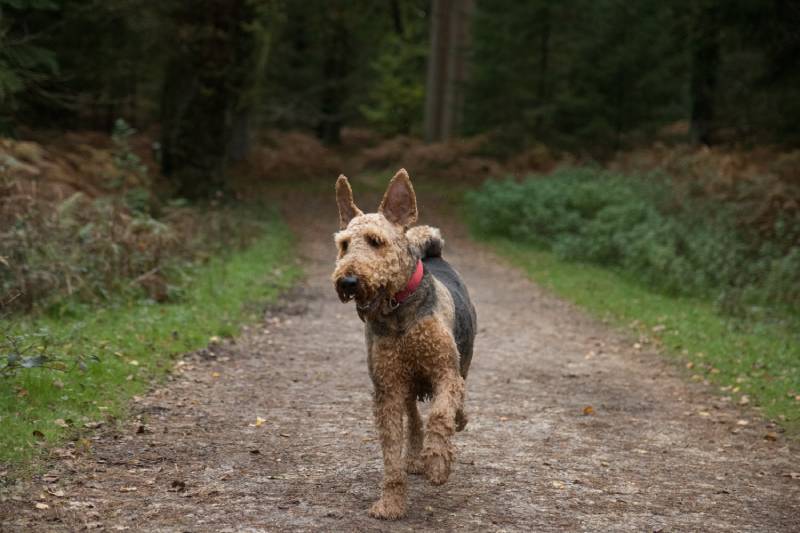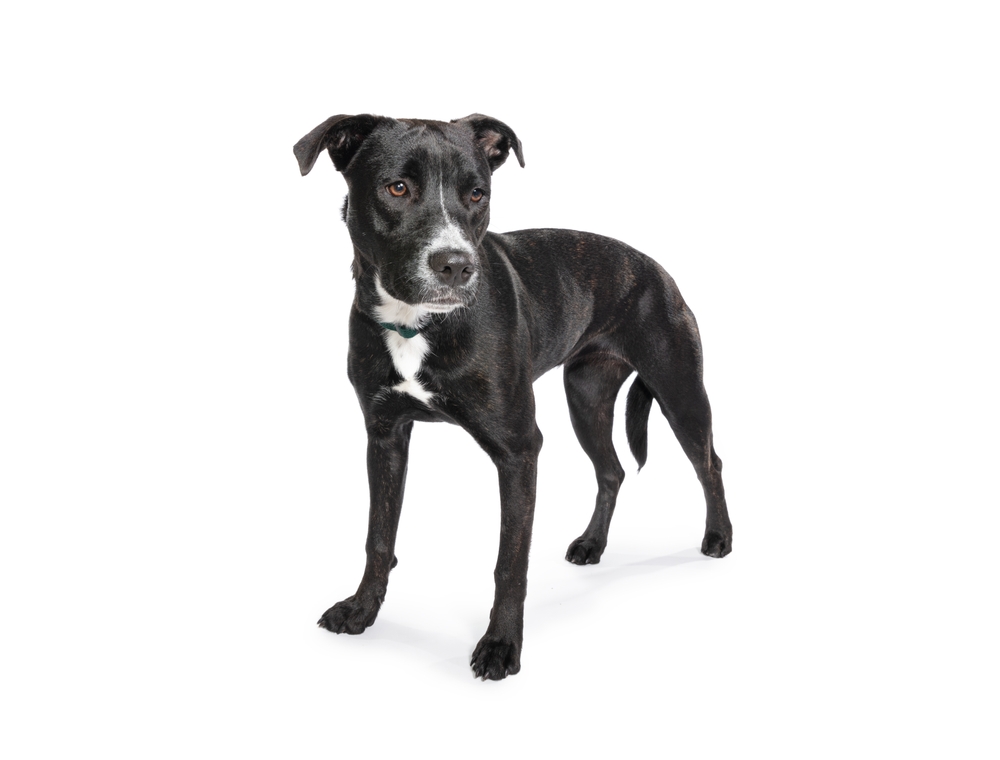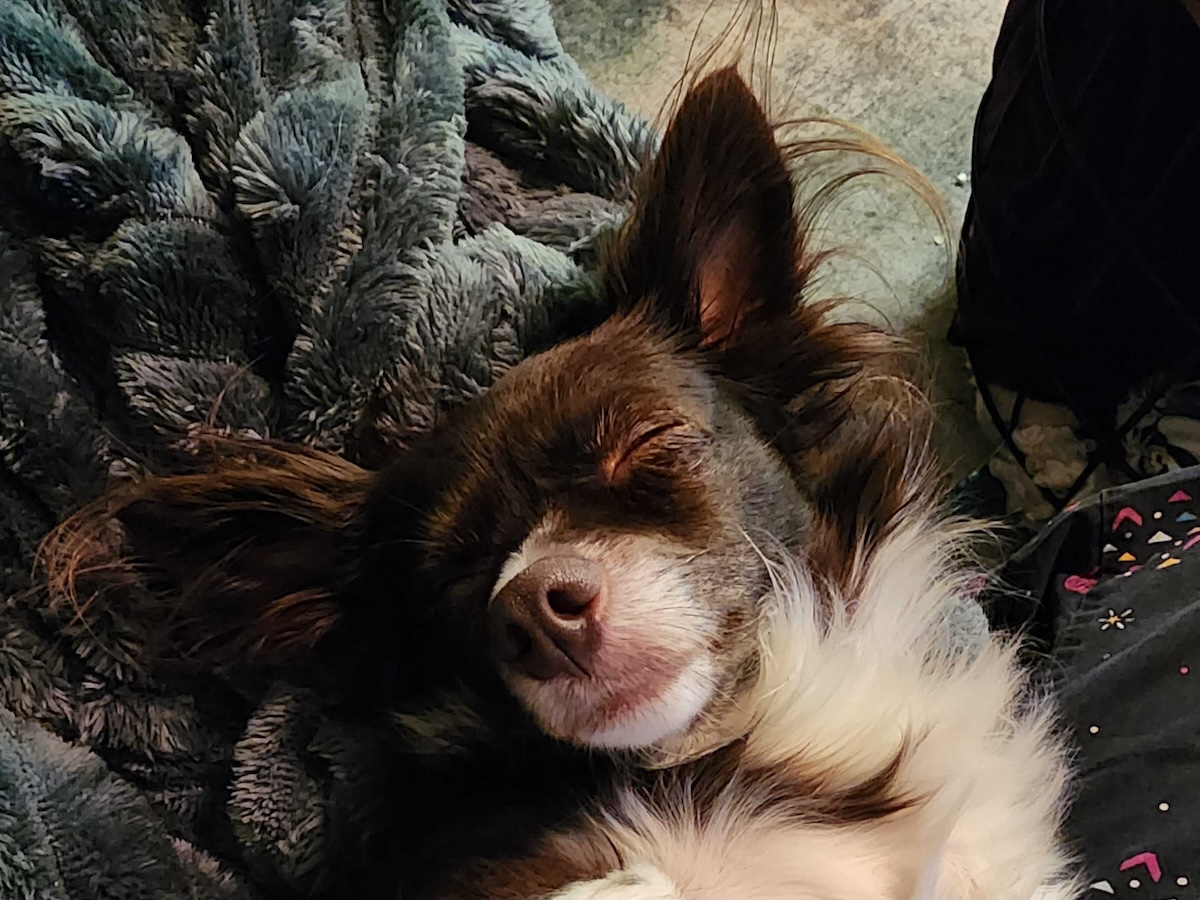Airedale Terriers are affectionately called the “King of the Terriers.” They are lovable creatures and make brilliant family pets. They can be stubborn, though, and require a great deal of exercise. Airedale Terriers are, unfortunately, also prone to certain hereditary diseases. It is important that owners are well-informed and understand the breed’s potential health problems before bringing one home.
Let’s explore the top eight health issues for Airedale Terriers.

The 8 Airedale Terrier Health Issues
1. Hypothyroidism
The thyroid gland sits in the dog’s neck near the windpipe. It controls the body’s metabolism and affects every cell in the body. Hypothyroidism occurs when the body does not produce enough thyroid hormone, leading to serious health issues.
- Hair loss
- Dry skin
- Weight gain with no change in appetite
- Behavioral changes
- Lethargy
- Sensitivity to colder temperatures
- Darker pigmentation on the skin
- Increased incidence of skin and ear infections
- Hair not regrowing after clipping
- Slow heart rate
This condition is usually diagnosed by clinical signs and blood tests. Total thyroxine (TT4) is measured in the blood. A low level of thyroxine, along with clinical signs, is usually suggestive of hypothyroidism. To definitively diagnose, a further test measuring free T4 by equilibrium dialysis is performed. If this test is also low, hypothyroidism is confirmed.
It can be difficult to diagnose, as sometimes dogs can have low TT4 but normal free T4. Your vet will discuss any testing and results with you. There is no cure for hypothyroidism; however, treatment is successful using hormone replacement therapy. Airedales can live a long time with a good prognosis once the treatment is started.

2. Gastric Dilatation and Volvulus
This is a serious condition that can be fatal. It is relatively common and is sometimes called gastric torsion or bloat. Airedales are prone to this due to their size and stature—they have deep, narrow chests, which facilitate this condition. The stomach can twist on its axis and fill up with gas quickly. The blood supply to the stomach and the spleen is compromised as the stomach twists. If left untreated, the condition can cause death very quickly.
- Large, distended stomach
- Hypersalivation
- Unproductive retching
- Pale gums
- Adopting the “prayer” position
- Pacing/restlessness
- Collapse
Bloat can occur on its own too. This happens when the dog’s stomach fills with solids (food), liquids, or gas, causing it to expand and put large amounts of pressure on other organs close to the stomach. It can happen quite suddenly.
If you are suspicious that your dog may have gastric volvulus, or bloat, seek veterinary attention immediately. Treatment involves stabilization of cardiovascular shock, aggressive fluid therapy, and pain relief on presentation. Your vet will then try to pass a stomach tube to decompress the stomach if possible. If the patient is stable enough for surgery, an emergency operation will be required to untwist the stomach and return the stomach and spleen to their correct positions. Sometimes, parts of the stomach wall and the spleen need to be removed if damage has occurred. A gastropexy procedure can be performed to prevent the stomach from twisting again.
3. Hip Dysplasia
This is a common problem that Airedales are predisposed to. It is an issue frequently seen in many breeds of dogs. Hip dysplasia typically occurs during the first year of life. The ligaments that stabilize the hip are loose, which causes joint laxity. The two parts of the ball-and-socket joint grind against each other, causing remodeling of the joint, meaning the bony surfaces become deformed. Severe inflammation occurs in the form of secondary osteoarthritis. It is a painful condition and causes a great deal of distress.
- Hindlimb pain
- Hindlimb stiffness
- Hindlimb lameness
- Reduced movement of the hip joint
- Muscle wastage over hind limbs
- Bunny hopping
- Reluctance to exercise
- Struggling to get upstairs
- Difficulty standing up
There are many treatment options for hip dysplasia. Some depend on the severity and others on the age at which the disease is diagnosed. Non-surgical options include anti-inflammatory medication, hydrotherapy, and exercise modification. Surgical correction can be carried out. Options include juvenile pubic symphysiotomies, triple pelvic osteotomy, total hip replacement, and femoral head and neck excision.
Remember that a well-balanced diet and an appropriate amount of exercise are important for maintaining good joint health. Keep your Airedale at a healthy weight, as being overweight puts undue stress on their joints.

4. Corneal Dystrophy
Corneal dystrophies are a group of diseases affecting the cornea in dogs. Airedale Terriers have a predisposition to this condition, and it usually presents when they are 4 to 12 months old. It develops in the center of the cornea and is a progressive disease that over time, affects the dog’s vision.
- White/grey “cloud” at the center of the eye
- Irritated eyes
- Redness of eyes
- Itchy eyes
- Corneal ulcers
Treatment depends on the severity and the clinical signs. Often, dogs do not react to the clouded area, and they get used to it, so their sight isn’t compromised. In some cases, topical treatment can be used. Severe cases require surgery to remove the mineral deposits, though there are risks and complications associated with the surgery.
5. Skin Issues
Terrier breeds in general are prone to dermatitis, and Airedales are no exception. It can be difficult to spot skin issues in Airedales, though, as their coats are thick and dense, so it’s important that owners check their coats regularly.
- Redness
- Skin sores
- Dryness
- Flaking skin
- Rashes
- Itching
Treatment of skin disease does depend on the underlying cause. Some treat the signs, and others address the underlying cause. There are topical medications, oral tablets, injections, and allergen-specific immunotherapy. Your vet will discuss suitable options with you.
Airedales often suffer from acral lick granulomas if sore spots and excessive itching cause the dog to repeatedly lick their skin until the top layer is removed, and a moist dermatitis develops. This can easily get infected. Other skin issues are encountered due to food allergies and seasonal hair loss.

6. Umbilical Hernia
An umbilical hernia is usually a congenital defect that occurs when there is an opening in the muscle wall close to the dog’s belly button, which enables the contents of the abdomen to protrude. Sometimes the hernia just contains a small amount of abdominal fat, but in more severe cases, parts of the intestines can become involved. There are different causes, but the most common is genetic predisposition, and Airedale Terriers tend to suffer from it more often than other breeds.
Signs of an umbilical hernia include protrusion of tissue close to the belly button
- Pain
- Heat at the protrusion site
- Lethargy
- Reduce appetite
- Vomiting
Some hernias resolve on their own. If they are irreducible or there is intestinal involvement, surgery to return the tissue to the correct site and repair the defect in the body wall must be carried out. If your dog is female, the hernia can be repaired when she is neutered, as it can be incorporated into the spay incision and repaired when the surgical site is sutured.
7. Cerebellar Abiotrophy
Cerebellar abiotrophy, also known as cerebellar cortical degeneration, is an inherited degenerative disease that causes the cells in the cerebellum (a part of the dog’s brain) to slowly die off. Airedale Terriers most commonly get juvenile-onset cerebellar abiotrophy, which is typically seen between 6 weeks and 6 months of age.
- Loss of balance
- Incoordination
- Posture changes
- Stiffness walking
- Wider stance
- Head shaking
- Falling over
Unfortunately, there is no cure for cerebellar abiotrophy. However, medications and therapy can improve your dog’s quality of life. Medications can relieve pain, and hydrotherapy and massages can be effective in improving circulation.

8. Juvenile Renal Disease
This is a disease process that involves abnormal development of the kidney cells when embryogenesis occurs. It is a serious disease that eventually results in renal failure and death.
- Drinking excessively
- Urinating excessively
- Passing blood in the urine
- Reduced appetite
- Weight loss
- Failure to grow at a normal rate
There is no specific cure or treatment for the disease. Management of the disease is the same as that of chronic renal failure. It can include phosphate phosphate-restricted diet, anti-sickness medication, gastro protectants, and intravenous fluid therapy.
Conclusion
Airedale Terriers are unique dogs. They can be rewarding to have as pets, but they require a great deal of exercise and mental stimulation. They are also prone to several different health issues. Some are congenital and others develop later in life. It is important that owners are aware of these so they can monitor their dogs for clinical signs to aid in early diagnosis.
By having good knowledge of the health problems specific to Airedale Terriers, you can give them the best quality of life and prevent predictable risks.
- See also: Oldest Dog Breeds
Featured Image Credit: PROMA1, Shutterstock











